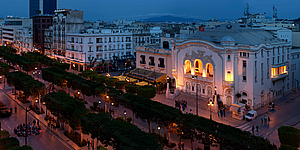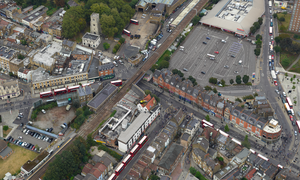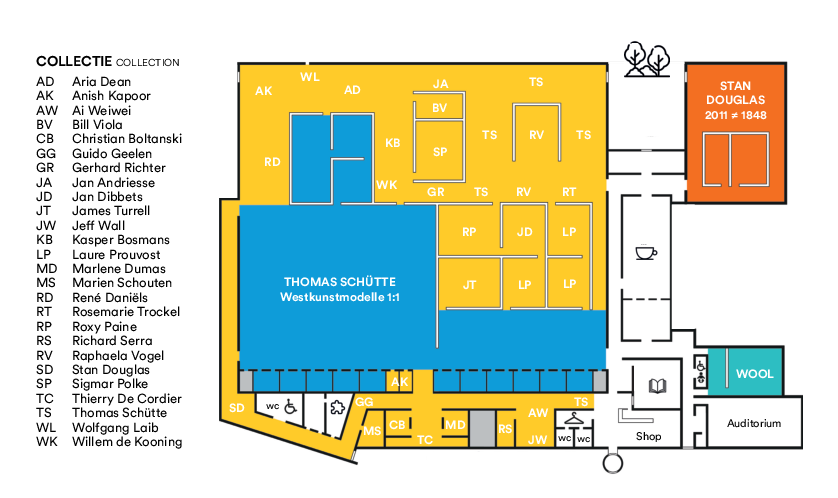2011 ≠ 1848
In his work, Canadian artist Stan Douglas (1960) subtly merges fact and fiction, history and current events, blurring the distinctions between them. This is true of his five-part photo series 2011 ≠ 1848 and video installation ISDN as well.
These five panoramic photos depict crucial moments from protests that took place around the world in 2011: the Arab Spring in Tunis, the occupation of Wall Street in New York City, the London riots in the Hackney borough and the Stanley Cup riots in Douglas’ hometown of Vancouver. For Douglas, the seemingly local protests express the wider sense of civic unrest felt around the globe. Through the title, he compares the protests to those of 1848, when citizens in various places in Europe rose up to demand democracy. That time around, the people were incited by posters and pamphlets. Rebellions were the result and 1848 went down in history as the year of revolution. By contrast, the unrest of 2011 – despite the speed at which it was able to spread on social media – continues to the present day. Which revolts will secure a place in world history and which will be dismissed as local disturbances? Douglas bases his ultradetailed photographs on news items and aerial photos. For these works, he meticulously reconstructed the revolts using actors, extras and props, capturing every detail in both the foreground and background in razor-sharp focus. The resulting photos offer the viewer both a bird’s eye view, and an invitation to come closer.
The work ISDN deals with resistance as well. In this video installation, Douglas emphasises how resistance can spread through music. The viewer finds themselves right in the middle of a rap battle between ‘grime’ rappers in London and ‘mahraganat’ rappers in Cairo. These two forms of street rap have much in common, despite the distance and cultural differences that separate them: in 2001, they each functioned as the soundtrack of youthful rebellion. In the video, the rappers seem to be responding directly to one another across a distance of 5,000 kilometres. This explains the title, which refers to the telephone wires that were used to transmit audio in the past. Yet ISDN is not a record of reality. Because the lyrics and beats were recorded individually and are being digitally recombined in a vast number of ways, days will pass before a given combination is repeated.
As in the photos, nothing is what it seems. Counterintuitive though it may be, through his careful staging of the situation, Douglas is attempting to offer insight into real events.

The video installation ISDN places you right in the middle of a rap battle between ‘grime’ rappers in London and ‘mahraganat’ rappers in Cairo. These two forms of street rap have much in common, despite the distance and cultural differences that separate them. They share a similar rhythm and social engagement. The title refers to the outdated network of telephone wires that was used to transmit audio in the past. Here, the rappers appear to respond directly to one another across a distance of 5,000 kilometres. Yet they have never set eyes on one another. Douglas recorded the raps separately and used a computer programme to arrange the beats and lyrics so that they would ‘respond’ to each other in varying ways. By doing so, he creates the illusion of an endless jam session that never took place and provides a tangible example of the energy with which cultural and political resistance can spread through music. The work also demonstrates that the similarities between cultures are often stronger than their differences.
ISDN, video stills (2021), © Stan Douglas. Courtesy of the artist, Victoria Miro and David Zwirner. Collection Hartwig Art Foundation. Promised gift to the Rijksdienst voor het Cultureel Erfgoed / Rijkscollectie.

Dusk has begun to settle in. On Boulevard Habib Bourguiba, in the Tunis city centre, groups of people begin to gather here and there. They sit on small carpets, stand in a circle around burning candles in front of the theatre or chat with one another in the glow of a streetlamp. Patrol cars and troops are present as well. Despite the peaceful nature of the image, the tension of an imminent outburst is palpable. Douglas has recreated a scene of people who have chosen to ignore the curfew. They congregate on the otherwise bustling boulevard to protest against the corrupt regime. The protests in Tunisia, which began in December 2010, marked the start of the Arab Spring.
© Stan Douglas. Courtesy of the artist, Victoria Miro and David Zwirner

On 10 October 2011, protesters in New York City joined the Occupy Wall Street movement in demonstrating against the greed of the financial sector. The protesters wanted to march – on the roadway – across the Brooklyn Bridge. Enforcement officials said they stopped the protesters to keep them from obstructing traffic. According to the protesters, however, the police had lured them onto the roadway, only to trap them halfway across the bridge. The action led to over 700 arrests. In his reconstruction, Douglas shows the photographers on the bridge (at the top left) in sharp focus, just like the faces of the protesters and the zip ties on the belt of one of the police officers.
© Stan Douglas. Courtesy of the artist, Victoria Miro and David Zwirner

With clenched fists and wearing the blue and green of the Vancouver Canucks ice hockey team, rioters yell and jeer next to a burning car. The ground is littered with trampled rubbish, photographed in extremely sharp focus, as if you could reach out and grab the objects. The team from Vancouver (the artist’s hometown) had just lost the Stanley Cup (the North American ice hockey championship) to the Boston Bruins, with a score of 0-4. This led to unprecedented riots that spread across the city like wildfire . Through this reconstruction, Douglas questions the random and pointless violence of that night in relation to the global unrest that occurred that same year.
© Stan Douglas. Courtesy of the artist, Victoria Miro and David Zwirner


From a distance, everything seems to be fine. Yet come closer and you will see plumes of smoke, burning cars and a police helicopter circling above a tranquil park in the London borough of Hackney. Between 6 and 11 August 2011, the United Kingdom was rocked by a series of major riots and protests. These ‘London riots’ broke out after the 29-year-old Mark Duggan was shot and killed by police during his arrest. The commotion quickly swept across the city and the country, spread in part via social media. Arson and looting occurred and five people were killed.
© Stan Douglas. Courtesy of the artist, Victoria Miro and David Zwirner

